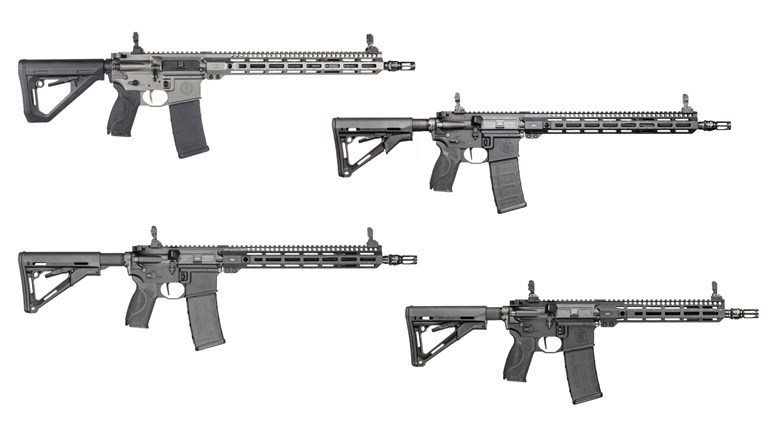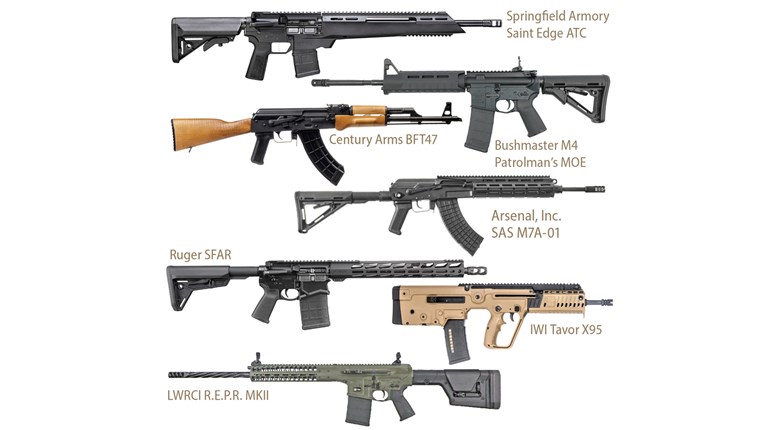
This feature appears in the December ‘16 issue of NRA America’s 1st Freedom, one of the official journals of the National Rifle Association.
Relative newcomer F-1 Firearms has an MSR worthy of Zeiss and Talley. So we decided to find out more from those who know the most—and best—about it.
A1F: Looking at the F-1 BDR-15 3G, we see a familiar “MSR” plan, but elsewhere are all kinds of differences. Was there a particular insight or experience that got your designers going in the directions they took?
Nate Harper/F-1: <<Laughing>> It sounds like something from a mediocre screenplay, but the owner and two designers were sitting around the shop, got the idea, and just drew it up. They’d be the first to admit that, originally, it was about the aesthetics; it looked cool. But the more we got into it, the more the engineering and operation of the rifle started to align—it “turned out” in an engineering sense, even if the beginning was sort of random.
Everyone stood back a little the first time we shot it, but it ran great. Naturally, we’ve fine tuned it, but the original conception turned out to be sound.
A1F: It’s remarkable how much material has been removed. But two questions then come to mind: What is the overall strength compared with solid metal, and how susceptible is it to contaminants?
NH/F-1: On the strength score, we start with the best materials. We work directly with Alcoa, and use 7075 aluminum. The dies are of our own design, and proprietary. This means the extrusions have billet-like strength despite the machining that produces the final rifle. Our testing—and now, considerable field work—show that the strength of the upper and lower are no different than if the parts were solid. Compared to a generic extrusion, our dies give us a starting point, strength-wise, that accounts for the machined-away metal.
Contaminants are pretty simple—easy in, easy out. Direct impingement lets the first shot blow the action amazingly clean. Sand, snow, muddy water, all have been tested with the same result: The first shot clears everything for the second and subsequent shots. It helps to control tolerances to the extent we do: All our upper/lower pairs are hand-finished, matched sets, which has many benefits.
A1F: Tell us what’s going on with the bolt carrier and bolt.
NH/F-1: We put our medium bolt in terms of life and lubricity in that rifle. It’s TiN: titanium nitride.
We’ll build a rifle with any of six different bolts, though it’s fair to say we have strong opinions about “good, better, best,” and a BCG finished in black nitride is a decent starting place for the once-in-a-blue-moon shooter. It’s roughly a 5,000-round bolt.

Nickel-boron is the next step, and a big one. It gives considerably better function in terms of smoothness and longevity. Three types of PVD (physical vapor disposition) come next, with friction falling steadily. The gold-colored TiN has a .45 coefficient of friction, silver-like CrN (chromium nitride) is at .30, and rose-colored TiCN (titanium carbon nitride) has a .20 coefficient. The king of the hill is our black DLC, “diamond-like coating,” and it’s about as close as you can get to a pressurized system of lubrication. Life is at least double a conventional bolt/bolt carrier, with reliability and ease of maintenance to match.
The PVD and DLC finishes are so tough that you’ll dent the steel underneath them before you’ll damage the coating itself.
A1F: It seems as though the hand guard, charging handle, safety/selector and comp trend to the high end as well?
NH/F-1: We think so, certainly, but they were chosen mainly to improve the all-around performance of the rifle, not just to check off a box on a features list.
The hand guard is our H7M. It’s a custom extrusion, and for the same reason: We have complete control over the quality at every point. It’s light but exceptionally strong, and has M-LOK rails at the 3, 6 and 9 o’clock positions, with Picatinny up top where you need it, and “scalloped” where you don’t. The Battle Arms Development ambi safety/selector is a rugged, versatile choice, as is the AXTS “Raptor” charging handle. Particularly on a competition gun, the both-sides operation is more than simply handy.
The comp is our own design. That configuration will keep a full-auto (mil/le) gun shot with one hand running flat. The rifle doesn’t climb or sink.
A1F: The “3G” designation certainly implies a purpose: 3-gun competition, which in turn implies a logic to barrel/gas system length, trigger selection and the like. What was the thinking here?
NH/F-1: No secrets here. It’s an out-of-the-box, sub-moa rifle, and often by a lot. All our rifles have this guarantee, which by the way follows the product. In terms of the barrel and gas system choices, we think it’s the best mix of functionality for a wide range of possible applications. Competition is an important one, but we have significant numbers of outfitters and mil/le users too. They like or need suppression, and this is another area where our slotted upper receiver shines—there’s no “spitting cobra” effect working through the back of the receiver. Venting as it does, back-pressure is reduced 80 percent, and occurs well before it can blow out of the charging handle cut and into your face and eyes.

Triggers, on the other hand, are highly personal, so we let customers choose. A HyperFire EDT II is stock. We have five others you can upgrade to suit: two more HyperFires, a Geiselle Automatics, or the flat or curved CMC single-stage.
A1F: And the barrel—what’s happening there in addition to good looks?
NH/F-1: Mainly, this is aesthetic, but that’s part of the fun. There’s a small weight reduction that may help the rifle swing better, but that varies shooter to shooter. Dimpled diamond, brick and standard flute, however, they’re about the same, weight-wise.
Inside is where the differences really are, though. 416RSS and 5R-rifled, we don’t produce anything but match quality, and all are drift- and air-gauged to a ten-thousandth.
A1F: Our rifle is your FDE camo, but lots of options show up on the website. Any more we need to know?
NH/F-1: Our standard black is Type III hard anodizing, and the colors, including splashes and camos, are anodized, too—not merely an applique or paint of some kind—so they’re mighty tough. For the most part, the variety we have is about having a world-class rifle that is identifiably “yours,” yet thoroughly functional, too. If you make us pick, “Battle Worn” is our favorite: It’s a nickel boron finish with a Rockwell hardness of 73. Add a DLC BCG, and that rifle simply runs like butter.
A1F: What do you think sets the F-1 BDR-15 apart from other MSRs?
NH/F-1: Several things come to mind. For instance, we’re not an “assembler”: 90 percent of the rifle is manufactured by us, and 100 percent American made. We also have a special sort of “thank you” for anyone who has served our nation—we’ll build them a personal rifle at a 20 percent discount.
We’re understandably proud of our innovation in the rifle itself, and of our color palette, but quality is the real number-one with us. Tolerances, materials and attention to detail are what set us apart. Take 10 different unlabeled MSRs at any price, and we’re completely confident we’d never finish out of the top two.
Nuts And Bolts
When there is so much great technology to talk about, we resort to sneaking the “how’d it shoot” into Nuts and Bolts. In a funny way, there isn’t much to tell: As you likely gathered from our conversation with Nate Harper, F-1’s director of sales and marketing, the F-1 rifles are essentially custom-built, and ours sure shot like it. Sub-MOA? Check. Marvelous fit and finish? Check. Fussy about mags? Uncheck: We tried six brands in various capacities; all flawless.
The only hiccup we had was with .223 ammo as opposed to 5.56 x 45. The latter was great in all varieties, but especially some 77-grain OTM; the former, somewhat touch-and-go. This is hardly uncommon, and we expect it would disappear in another couple hundred rounds. If not, we’d tune a David Tubb flatwire spring, and move on. (These seem to work every time, including with the F-1).
But between the F-1 and our test optic/mount, it’s hard to say which was more breathtaking. Many readers will have instantly recognized that dignified blue pennant as the marque of Germany’s Carl Zeiss, and think, “Well, no wonder the rifle shot like a dream!” To which we reply, “Yes. And your point would be?”
Our 1-8x “Victory” absolutely did render us the weak link, but we’ll cheerfully be propped up by a Zeiss/Talley combo at any opportunity. The rail on the F-1 was within about a dozen clicks of mechanical center on the Victory, so between the rock solid 36 mm rings and the “60 Reticle,” (reminiscent of the classic “German #4,” with the addition of an ultra-precise, illuminated center dot), we could hit whatever we chose. If that tube seems outsized, you are correct. However, it makes possible huge adjustment range to complement the extremely bright (92 percent) light transmission. As we said: Breathtaking.
Contact F-1 Firearms at f-1firearms.com. F-1 rifles start at $1,200.

































